Tassar silk, also known as Tussar silk, is a type of silk produced from the silk-producing larvae of several species of silk moths. Tassar is derived from the Sanskrit word “Kosa,” which means silk. The silk is valued for its rich texture, natural gold color, and versatility.
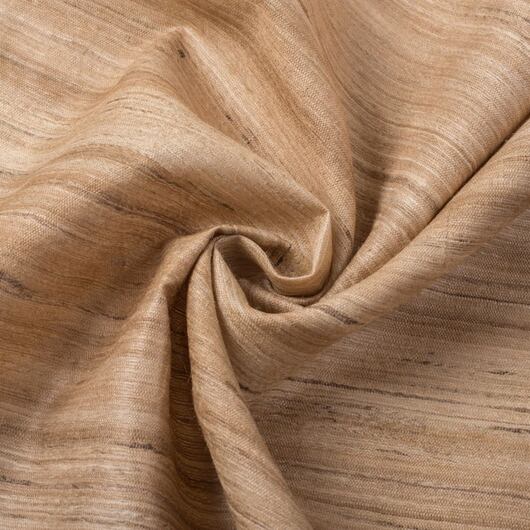
Tassar silk moth Antheraea Millita
It is also known as Wild Silk, derived from the Tussar silk moth Antheraea Millita. These moths are nourished with leaves other than mulberry, producing wild silk fabric at a more affordable cost. Tussar or Kosa silk stands out as one of the most convenient fabrics to drape. It exudes a rich and regal feel while maintaining a lightweight quality. Additionally, its porous nature imparts a cooling effect, making it particularly suitable for individuals residing in warmer regions.
The combination of elegance and cost-effectiveness positions Tussar Silk as the preferred silk for special occasions. One of its noteworthy advantages lies in its ability to refract two different shades at varying angles. This distinctive feature ensures that individuals adorned in Tussar silk easily stand out in a crowd.
Some key details about Tassar Silk
Silk Moths Species:
Tassar silk is primarily produced by the larvae of several moth species, including Antheraea mylitta, Antheraea proylei, Antheraea pernyi, and Antheraea roylei. Among these, Antheraea mylitta is commonly used for commercial Tassar silk production.
Geographical Origin of Tassar Silk:
This silk is produced in various regions, including India, China, and parts of Southeast Asia. In India, It is particularly associated with states like Jharkhand, Bihar, Chhattisgarh, and Orissa.
Read – Folk dance of Jharkhand and Division of Jharkhand on Chotangpur
Characteristics of Cocoon that produces Tassar Silk:
The cocoons of Tassar silk moths are usually larger and more textured compared to those of the mulberry silk moth, which is another widely used silk-producing species. Its cocoons have a rough texture and a natural golden or beige color.
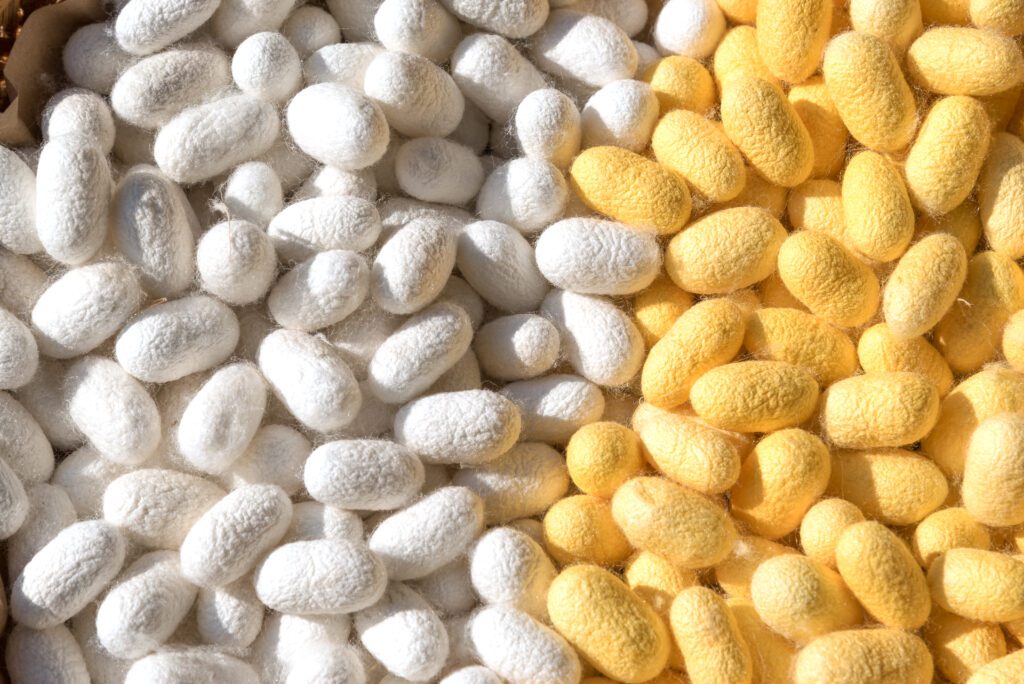
Natural Color and Texture of Tassar Silk:
Tassar silk is known for its natural gold sheen, which gives it a distinct appearance. The coarser texture of the silk adds to its appeal, making it suitable for a range of traditional and contemporary clothing.
Production Process
The production of silk involves the rearing of silkworms, cocoon harvesting, and the extraction of silk fibers. The process is similar to that of other varieties, but the coarser texture and distinctive color of Tassar silk set it apart.
Here are the following steps to produce Tussar silk:
1. Rearing
Sericulture is gathering silkworms and harvesting cocoons to collect the materials. Silkworms deposit eggs, leading to the emergence of larvae. Upon reaching the pupa stage, the larvae stop feeding and construct a protective cocoon. Fixed with support in the tree, the silkworm initiates the creation of its silk cocoon by executing a figure-8 movement continuously. This intricate process spans from 3 to 8 days. Each silkworm generates a solitary strand of silk, stretching around 100 meters in length, held together by a natural gum known as sericin.
2. Thread extraction:
In this process, silk is extracted once the silkworms have spun cocoons and eventually enclosed themselves inside. The gum (also called Sericin) holding the cocoons together is softened and dissolved by submerging them in boiling water. As it guarantees that the continuity of each thread is intact, this is an essential stage in the manufacture of silk. After that, each thread is cautiously removed from the cocoon and wound into separate, lengthy strands before wound onto a reel. Some sericin may still be present on the threads to preserve the fibers during processing, although this is often removed with soap and boiling water.
3. Dyeing
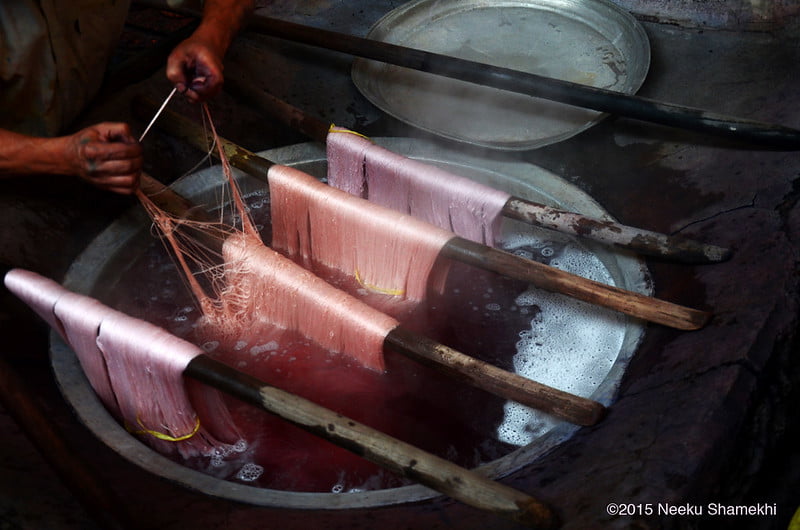
After extracting silk threads through cleaning and degumming, silk is bleached and dried before the dyeing process. The natural resources available in the surroundings, such as fruit or the leaves of the plant, are used to make the dyes used in traditional silk dyeing processes by boiling them. Due to technological advancements, many kinds of dyes, like reactive or acid dyes, are also present which allows a wider selection of colors and tones to choose from.
4. Spinning:
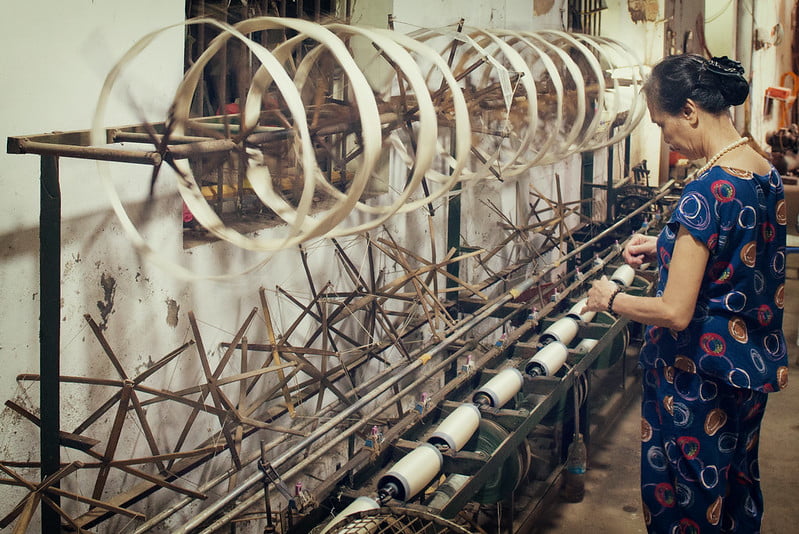
The traditional spinning wheel has always been an integral part of silk spinning. Nowadays, industrial processes allow silk to spin more quickly.
5. Weaving
The finished piece of silk is assembled through the process of weaving. Silk can be woven in a variety of ways; the most popular weaves are satin, plain, and open weaves. The style of weave will determine how the silk is finished.
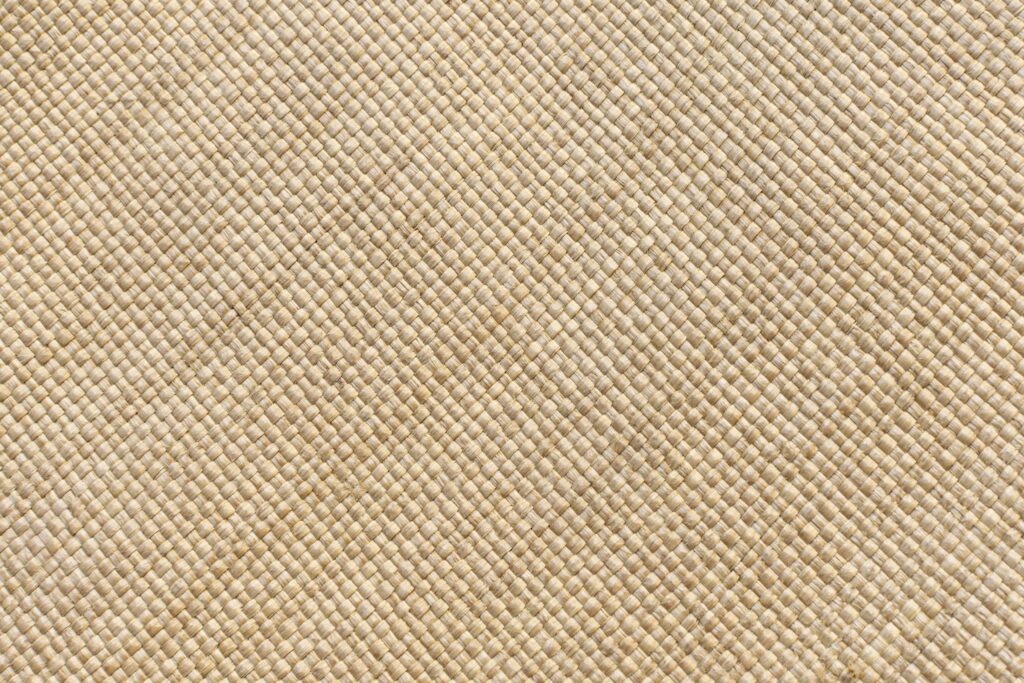
Uses of Tassar silk:
Tassar silk is commonly used to create a variety of textile products, including sarees, dress materials, dupattas, scarves, and other traditional Indian garments. The natural golden hue of Tassar silk makes it an attractive choice for festive and ceremonial wear.
- Tassar silk is often associated with handloom weaving, and many artisans and weavers in India use traditional techniques to create intricate designs and patterns on the fabrics.
- It is also used as an additive to soap. The short fibers are typically dissolved in lye water and added to oils to make soap. Soap made with Tussar silk has a unique quality that gives a more luxurious feeling than regular soap. Also read – Different Types of Sarees
- Tassar silk is considered more sustainable than some other types of silk, as the silkworms are not killed during the extraction of fibers, also referred to as Ahimsa Silk. The process of harvesting Tassar silk is often more eco-friendly, making it a preferred choice for those looking for sustainable silk options.
In summary, Tassar silk is a distinctive and versatile variety of silk known for its natural golden color, coarser texture, and cultural significance in the regions where it is produced. It has a unique charm that makes it popular for various traditional and contemporary textile applications.
